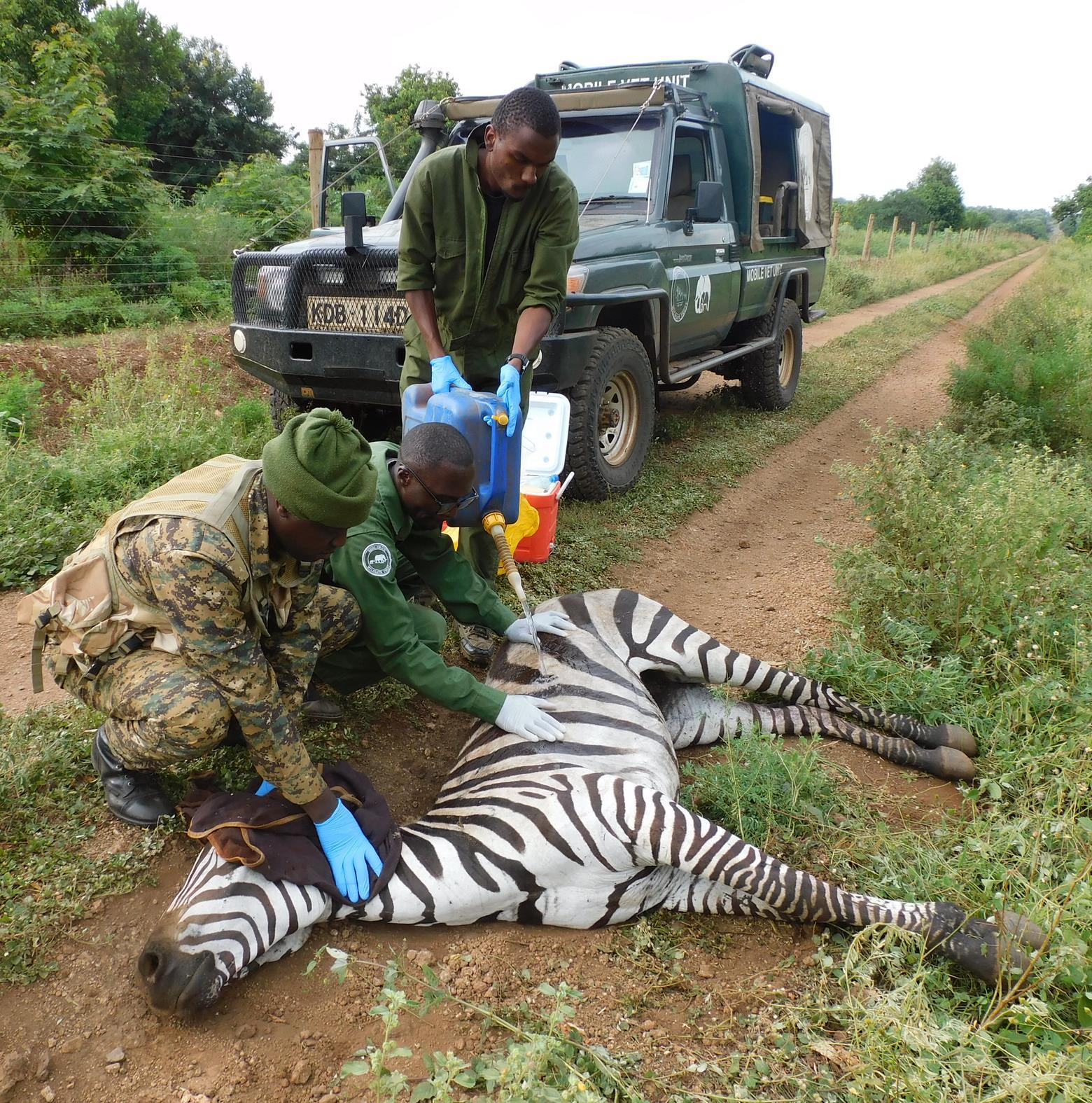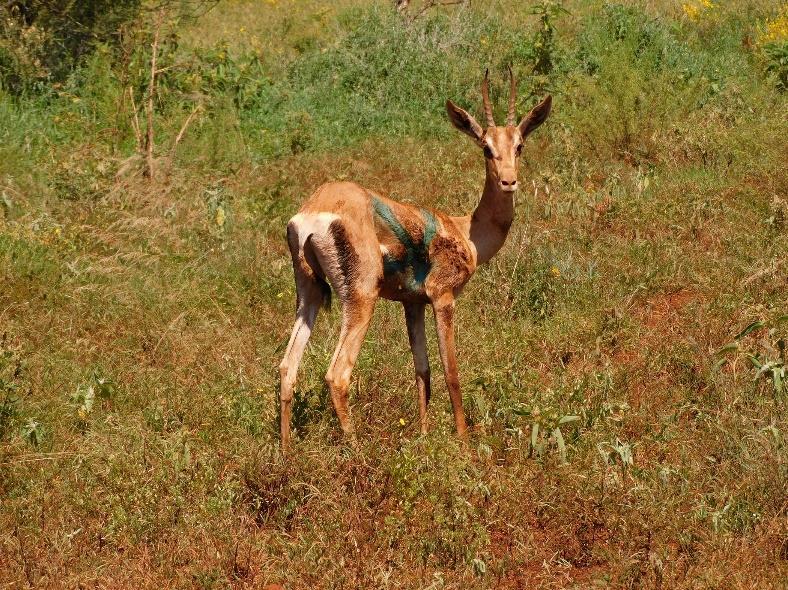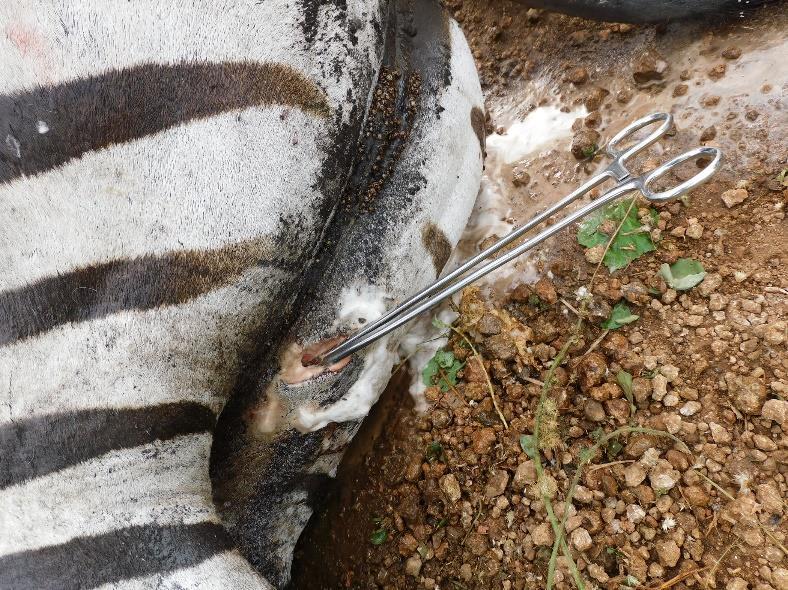6 Cases in May
May Report by Dr.
Aminga Duncan
1 Rhino Case
1 Elephant Case
May was notably dry with minimal to no rainfall recorded in the Meru ecosystem. Nevertheless, permanent and seasonal rivers continued flowing, and the region retained its verdant appearance. The SWT/KWS Meru Mobile Veterinary Unit attended to 6 cases In lower Imenti Forest, the team performed an autopsy on an adult elephant bull that was found to have died from intestinal torsion and hypoxia. All the other cases were in Meru National Park. The Veterinary Unit also rescued a sub-adult female white rhino named Noleen after she strayed from the Meru Rhino Sanctuary. They also attended to an adult male lion and a sub-adult female Grant’s Gazelle in separate cases. Both animals exhibited marked lameness. Furthermore, the team treated a female common zebra in Meru National Park that was electrocuted by an electric fence. Unfortunately, the zebra did not survive despite the team’s valiant efforts. Lastly, the veterinarian carried out a routine health checkup on a security dog assigned to the Rhino Canine Unit.
Acknowledgement
We wish to express our sincere appreciation to Sylvie Chantecaille for the unwavering and generous financial support extended to the Meru Mobile Veterinary Unit through the Sheldrick Wildlife Trust. We are also grateful to Kenya Wildlife Service, specifically acknowledging the Senior Assistant Director-Eastern Conservation Area and the Head of KWS-Veterinary Services Department for their administrative support. Furthermore, we appreciate our conservation partners and everyone who helped ensure the success of our varied interventions.
Case Details
May 2024
Case 1 – 20th May 2024
Lion
Natural Causes
Meru National Park
During a routine wildlife health assessment in Meru National Park, the Meru Mobile Veterinary Unit received a report of a male lion exhibiting lameness in his right forelimb. The veterinary team promptly drove to the reported location to administer the necessary medical care.
Immobilisation, examination and treatment
The lion was found resting under the shade and appeared to be in good health with a body condition score of 3.5 out of 5. He exhibited slight lameness in his right forelimb, but it was not severe enough to require immobilization. Two days earlier, he had been seen mating, and it was suspected that the lameness resulted from a minor altercation with the female during the mating process. This injury was expected to heal naturally within a short period. The lion monitoring teams were instructed to keep the veterinarian updated on his condition.
Prognosis
The lion has a good prognosis. A week later, it was reported that he was doing well, and the lameness had resolved.
Security Dog Technical Case
Meru
National Park
Security dogs are essential to wildlife conservation efforts, particularly in Meru National Park where they play critical roles in anti-poaching operations, tracking wildlife, and detecting wildlife contraband. Maintaining their health is crucial to ensure they perform these tasks at peak efficiency thus the need for regular veterinary check-ups. Consequently, the SWT/KWS Meru Mobile Veterinary Unit examined a female Dutch Shephard security dog named Parker to assess her well-being.
Examination
Parker was given time to acclimate to the veterinarian. She was thereafter physically restrained, and a general body examination revealed she was in good physical condition with a body condition score of 3.5 out of 5. Her coat was observed to be shiny and smooth, with adequate overall muscle mass.
Vital parameters, including heart rate, pulse rate, and respiratory rate, were measured and found to be within normal ranges. Her nails were clipped to prevent ambulatory issues associated with overgrown nails and all vaccinations were confirmed to be up to date. The handlers were advised to maintain proper hygiene in the kennel and adhere to the recommended feeding and grooming routines. Parker is currently in good health with no concerns noted.
Case 3 – 24th May 2024
Grant’s Gazelle Natural Causes
Meru National Park
While on a patrol within Meru NP, the Veterinary Unit encountered a solitary sub-adult female Grant's Gazelle with a notable swelling at the coronet of her left hind leg. She exhibited leg carrying lameness.
Immobilisation, examination and treatment
The gazelle was darted from the vehicle with a 2mg Etorphine and 10mg Azaperone. A malfunction of the 1st dart necessitated firing a 2nd dart with the same dosage. The dart successfully landed on the right thigh and the effects of the drugs were evident within 2 minutes. The gazelle was promptly secured and blindfolded then the anaesthesia was reversed with 50mg Naltrexone before proceeding with physical examination.
The gazelle was found to have a contaminated open wound on its left hindlimb that was believed to have been caused by a tree stump. The maggot infested wound was cleaned with water, the maggots were manually removed, then the wound was flushed with Hydrogen peroxide and disinfected with Iodine. An antibiotic ointment was applied before the wound was covered with green clay and sprayed with an antibiotic aerosol. To address inflammation and bacterial infections, 10mg Dexamethasone and 1,500 mg Amoxicillin were administered. Additionally, metabolic stimulators and antiparasitic medication were also given.
Prognosis
The gazelle was released 10 minutes post-treatment. It has a good prognosis.
Elephant
Post-mortem Themba Area, Lower Imenti Forest
The SWT/KWS Meru Mobile Veterinary Unit performed a post-mortem examination on the carcass of an adult male elephant found in the Themba area of the Lower Imenti Forest to ascertain the cause of death.
Post-mortem findings
The carcass was found lying on its chest, with abrasions on the elbow and knee joints. The elephant's body condition was fair, scoring 2.5 out of 5 on the body condition scale.
External examination revealed an eye injury likely caused by a blunt object such as a tree stump. An abscess was found on the left flank, likely stemming from a previous injury due to its healed state. Furthermore, there was an open contaminated superficial wound on the right thoracic area. The oral mucosa and tongue displayed a slightly bluish hue, indicating possible hypoxia.
Internally, examination of the abdominal cavity revealed pronounced pyonephrosis, primarily affecting the right kidney. The liver was firm and enlarged with rounded edges and pinpoint haemorrhages, while the spleen was pale and enlarged. Notably, there was inconsistency in ingesta distribution within the intestines. Dry forage mixed with gravel sediment was obstructing normal peristalsis distal to the pylorus. Some sections of the intestines lacked ingesta altogether, while others displayed heightened levels of mucus. Within the thoracic cavity, the heart appeared normal in size and appearance, whereas the lungs appeared pale and contained froth extending from the bronchi to the bronchioles.
Cause of death
The elephant bull suffered from intestinal torsion, a condition characterized by restlessness, abdominal pain, and general body weakness. This condition led to the elephant's collapse and subsequent death due to hypoxia resulting from prolonged chest compression.
Zebra
Human-Wildlife Conflict
Meru National Park
During the autopsy investigation in the Themba area, the Meru Mobile Veterinary Unit was notified about a female common zebra observed with an injury to the right hindquarters within Meru National Park. Additionally, the team received information indicating that the same zebra was found lying adjacent to a road after contacting an electric fence and exhibited signs of convulsions.
Immobilisation, examination and treatment
The zebra was found lying on its right side on the road, displaying signs of respiratory distress. It was physically restrained and blindfolded to facilitate veterinary intervention. To mitigate the elevated body temperature of 42⁰C, copious amounts of water were applied to cool the body.
Examination of the surroundings revealed evidence of an electric shock, resulting in loss of muscle control and severe neurological impairment. The zebra exhibited weakness, minimal eye reflexes, and difficulties in ambulation and head movement, indicative of suspected spinal cord injury. Treatment included the administration of respiratory stimulants and anti-inflammatory medications. The wound on the hindquarters was promptly irrigated with water, disinfected with Hydrogen peroxide and Iodine, treated with antibiotic ointment, and covered with green clay. Sadly, despite intervention, the zebra succumbed during treatment.
Rhino Relocation
Meru National Park
The SWT/KWS Meru Mobile Veterinary Unit was notified that a sub-adult female white rhinoceros named Noleen had strayed from the confines of the protected rhino sanctuary within Meru National Park into the adjacent community area. Various KWS Security teams were dispatched to trace her movement, and upon locating her footprints, aerial assistance was sort from both the KWS helicopter and fixed-wing aircraft. Following an extensive search operation, the rhinoceros was eventually sighted.
Rescue
The process of returning Noleen to the protected sanctuary involved coordinated efforts between ground teams, the Kenya Wildlife Service helicopter, and fixed-wing aircraft. To ensure Noleen's well-being and prevent exhaustion, ground teams monitored her overnight before resuming the relocation process the following day. During the early morning on 30/05/2024, various teams including those from the KWS Veterinary Headquarters, security teams stationed in Meru National Park, the Mt. Kenya Mobile Veterinary Unit, and Meru Mobile Veterinary Unit, collaborated to relocate Noleen back to the sanctuary. This involved carefully guiding her through a section of the fence that had been taken down with aerial support from the KWS helicopter and fixed-wing aircraft. Noleen was observed to be in good physical condition, and it is anticipated that she will adjust well to her return to the sanctuary.





















